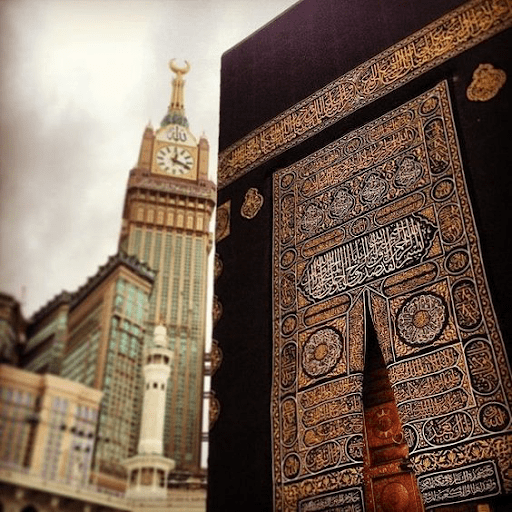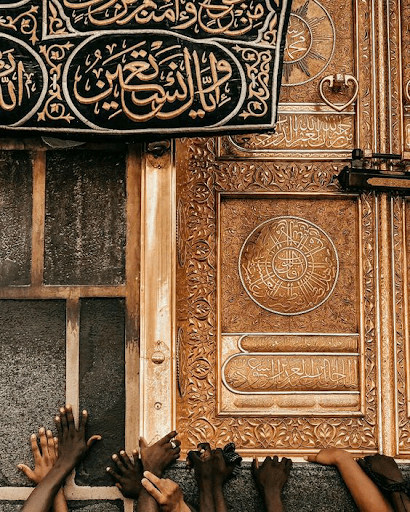The Kiswah: A Simple Way to Connect with the Kaaba
- Home
- Makkah Ziyarat
- Kiswah
As you go closer to the Holy Kaaba in Masjid Al Haram, the Great Mosque of Makkah, Saudi Arabia, you can’t help but notice a distinct and pleasant smell that surprises you. As you approach the House of Allah SWT, the scent of a heavy, strong perfume becomes more overpowering. The beautiful silk garments known as the Kiswah that envelop the Holy Kaaba are the source of this fragrance.
The Kaaba opens thirty days before the Hajj and thirty days before Ramadan each year. On the ninth day of Dhul Hajj, when pilgrims ascend Mount Arafat, the Kiswah is, however, changed yearly. Everything you need to know about Kiswah and its importance in Islam is provided here.

The custom of covering the Kaaba with a cloth has its origins in the early days of Islam and goes back many centuries. It is said that this custom was started by the Prophet Muhammad himself in the early days of Islam. The Kaaba was originally covered with plain textiles made of woven materials. But as the custom changed throughout time, the elaborate and elaborately made Kiswa that we see today was born.

The Holy Kaaba’s (Kiswah) cover has a beautiful design. Most people are curious, nonetheless, about the condition of the exquisitely carved Arabic calligraphy in golden hue. Millions of Muslims go from all over the world to the Holy Kaaba each year to perform the Umrah or Hajj. The Kiswah is made up of 47 garment strips, each measuring roughly 14 cm in length and 101 cm in width.
Ya Allah” is written with His two names. “Ya Hannan,” which means “Merciful towards servants,” and “Ya Mannan,” which means “Tremendous in Giving.”
“La Illaha Illa Allah Muhammad Ur Rasulullah” which means “There is no God except Allah and Muhammad PBUH is His last messenger.”
“SubhanAllah hi Wabihamdi hi SubhanAllah hil Azeem,” which states that “Allah is free from any kind of imperfection, and all praise is for Allah. Allah is free from any kind of imperfection; Allah is the greatest.”
As stated earlier, most of the gold embroidery on the Kiswah is of relevant verses from the Holy Quran. The following verse is embedded on the side of the Kiswah from Rukan Yamani and Hajr al-Aswad:
“In the name of God, Most Gracious, Most Compassionate. That is so. And whoever honours the symbols of Allah, it is certainly out of the piety of the heart.” [Surah Hajj: 32]
Traditionally, the Kiswa is made from black silk, which stands for Islam’s universality, simplicity, and humility. The color black also stands for putting
spirituality first and avoiding worldly distractions. Verse motifs from the Quran are frequently embroidered on the fabric using gold thread, giving it an air of solemnity.
Skilled artisans and craftsmen go through a complex process to make the Kaaba Cover. After a complex ceremony done in Mecca, it is usually replaced once a year during the Hajj season. Then, with great care, the fresh Kiswa is draped over the Kaaba to represent rebirth, purity, and the never-ending cycle of worship.


The black fabric’s consistency represents the Muslim community’s unity across national, cultural, and ethnic divides. It acts as a reminder that all believers, regardless of their upbringing or social standing, are equal before God.
The Kaaba, the center of Muslim worship, symbolizes Islam’s spiritual core. By covering the Kaaba, the Kiswah strengthens the spiritual bond between God and His worshippers by acting as a material manifestation of respect and devotion.
The yearly Kiswa replacement represents spiritual cleanliness and a revival of faith. It emphasizes the value of maintaining one’s spiritual purity and constantly pursuing holiness in God’s eyes.
The Kaaba Cover reflects Islam’s rich history and legacy with its beautiful layout and workmanship. It connects generations of believers in an eternal relationship of faith and tradition, acting as a bridge between the past, present, and future.
The Kaaba is covered by the Kiswa, which keeps it safe from the weather and maintains its holy status. It represents the idea of guardianship, which is the responsibility of Muslims to protect their holy sites and maintain the principles of their religion.
The day of globalization, Muslims all across the world still place a great deal of importance on the Kaaba Kiswa. It crosses national and cultural barriers as a potent symbol of identity, faith, and unification. The yearly custom of changing the Kiswah during the Hajj season serves as a moving symbol of believers’ shared quest for enlightenment and spiritual fulfillment. It serves as a tangible expression of the spiritual journey undertaken by millions of believers worldwide.
Furthermore, the Kaaba Kiswa has come to represent the unchanging principles of Islam in a world that is always changing, serving as a source of inspiration and pride for Muslims. It serves as evidence of the unwavering legacy of piety and devotion that has kept the Muslim community alive for many years.